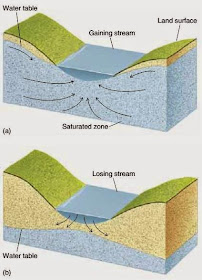 What is geochemical sampling?
What is geochemical sampling?
Geochemical sampling is taking a small portion of Earth's material for finding its mineralogy, composition and grade such that it represent the whole area. Geochemical sampling is the basic technique used for the exploration of minerals and their ores. So for this exploration multiple sampling techniques can be used to determine the place of ores. There are several methods of sampling
- Stream sampling
- Vegetation sampling
- Hydrogeochemistry
- Soil sampling
- Gas sampling
- Rock sampling
Stream sampling
Stream sampling is the samples taken from stream running through area and providing water and sediments from catchment area. These water when flow in stream it provides picture of the area from where water flows out. The stream source of sediments are by erosion of soil and rocks. It also gets water from inflow ground water which gives the subsurface mineralogy. So taking samples from the stream requires choosing area which provides picture of whole stream, sediments should be 80 mesh size acquired by sieving. Gold, magnetite concentrates in the stream sediments will settle down on the sieves as they are heavy minerals and finer sediments will be sieved.
For base metals and geochemical mapping 0.5 kg sample should be taken but for Gold 10 kg sample should be analysed. For an active stream sampling should be at interval of 20-30 meters or 50-100 meters. Sampling should be from a depth of 10-15 centimetres to avoid excessive Iron and Manganese oxides. Panning should be done for Gold, Zinc, Garnet, Magnetite and Diamond.
Vegetation sampling
Vegetation sampling should be done where soil and ground water chemistry knowledge is required. It is useful in areas where soil samples are not available.
Geobotanical survey
Geobotanical survey is looking for a specific specie presence or absence that can indicate mineralization or specific rocks type. Certain plants especially flowering plants act as a exploratory guides or indicator to certain elements. Other cases are discoloration or stunted growth of plants. Example Mauve Cu flower or Beccium Humblei of Zambian Cu belt requires 50-1600 ppm (parts per million) to thrive.
Biogeochemistry
Biogeochemistry is the most used sampling technique in countries like Siberia and Canada where soil sampling is not easy so plant sampling is acquired to understand the subsurface geochemistry. Plants need most trace elements which are transmitted from ground through roots. Sampling is done through one plant specie where its first or second year leaves and twigs and samples. Sample 0.5 kg is then burned to ash which will be analysed through XRF, XRD and AAS.
Hydrogeochemistry
Water is used as medium of sampling because ores and minerals have effect on composition of water through dissolution. This technique have restriction as not all elements have equal dissolution rates, Some are insoluble, trace element concentration is very low to detect, Concentration is highly depending on climate and weathering, easily contaminated and ineffective in dry conditions.
However it is useful in areas where network of interconnected streams are present. Effective for fluorine and associated minerals, dissolved uranium and radon can help for uranium ores exploration and areas where sediments are not available. Lakes and bogs water are analysed for underlying mineralizations.
Soil sampling
Soil are of two types and accordingly can be used.
- Residual soil
- Exotic soil
Residual soil
Residual soil are those which are derived from the underlying rocks and gives clear picture of the subsurface. It is effected in areas where rock outcrop is not available so for this purpose selection of horizon is important. Soil horizons are OABC where B horizon is sampled because it is zone of accumulation and provides overall soil mineralogy. Where B horizon is not present so any horizon can be samples or all of the soil can be samples. Usually 100-200 grams is samples for lead, zinc, copper and 0.5-2 kg for gold.
Exotic soil
Exotic soil are those which is derived from other places so these can be used in glacial environments and is sandy desserts where finer particles are blown away so coarser are sampled for geochemical surveys.
Gas sampling
Gas sample are used as they can diffuse through over burden. A number of gases are used in finding different ores. Mercury is used for mercury deposits, uranium deposits and sulphide deposits. Radon and helium and gases used as an indicator for uranium deposits. Sulphide di oxide is used for oxidising sulphide mineralization.
Rock sampling
Rock sampling is the most reliable and flexible method where large outcrops are available because rocks cannot be contaminated easily. Rock samples can be directly used for rock types, structure, mineralization and alteration. Rock sample can be stored for later examination and testing. Limitation in rock sampling are: outcrop not always available, scope is narrow and it shows only specific site not entire area. 0.5-1 kg samples is used for base metals and 10 kg sample for gold. Rock sample testing can only be done in laboratory and it consumes time.










